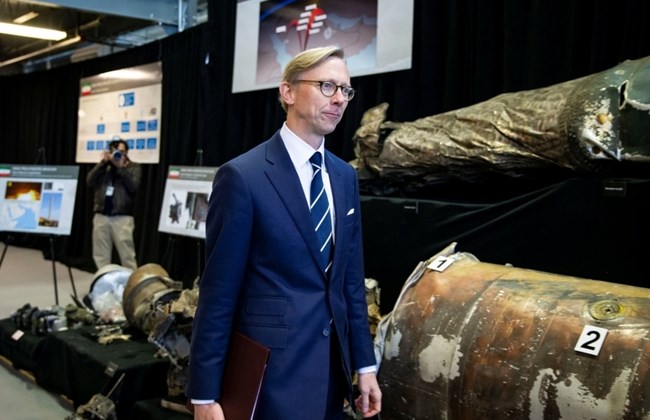The Iranian embassy in Kabul has dismissed claims that it has links to weaponry reportedly marked as being made in Iran and found in the central province of Ghazni. Local officials there announced on December 9 that they had found “Iran-made” weaponry in a Taliban hideout in the provincial capital, Ghazni City.
“These weapons, as you see, are very new. They were in the hands of the armed opposition of the government, and have been produced by Iran and delivered to the Taliban for the continuation of war,” the police commander of the province, Ghulam Daoud Tarakhel, said according to Sputnik Afghanistan.
Ghazni Governor Wahidullah Kalimzai said that around nine light weapons that were recovered by the security forces are made in Iran. Afghan officials claim the arms include nine Kalashnikovs, five pistols, a hand grenade and a large number of bullets.
Meanwhile, the Iranian embassy in Kabul has denied accusations in an official statement issued on December 10, and warned against those who attempt to harm growing bilateral ties.
"Political, economic and cultural relations between Iran and Afghanistan are at their highest level, and we mustn't allow these growing relations to be harmed or disrupted in any way," Iran’s Young Journalists Club website cited the statement as saying.
Afghan officials have often accused Iran of supplying arms to the ultraconservative group known as the Taliban, but Tehran has repeatedly rejected allegations that it aids it, saying such claims are instigated by the United States in an attempt to divert public opinion from the real cause of violence in Afghanistan.
The Pentagon and the U.S. State Department have routinely criticized Iran’s actions in Afghanistan, and recently announced that Iran is breaking United Nations resolutions by aggressively sending arms to rebel groups in the region.
Furthermore, Brian Hook, the U.S. Special Representative for Iran and the Iran Action Group chief, said on November 29 that Iranian arms displayed by the Pentagon are, "new evidence of Iran's ongoing missile proliferation.” He stressed, “the Iranian threat is growing and we are accumulating risks of escalation in the region if we fail to act," Radio Farda, the Persian bureau of RFE/RL, reported.
In line with the U.S.’ accusation about Iran's link to the Taliban in Afghanistan, the Pentagon displayed a number of Fajr rockets that it said Iran had provided to the militant group. It said the rockets were Iranian because of their unique markings and the paint scheme.
U.S. intelligence agencies have warned that despite coalition bombing increases in 2017, which reached a record high, the Taliban has continued to make gains in the country. According to the U.S. military's Special Inspector General on Afghanistan Reconstruction (SIGAR), Afghan authorities’ control or influence amount to little more than half of the country.
The threat level by the Taliban across the country’s 407 districts is high, and 30 districts are under full Taliban control. The main goal of the Afghan government and its international allies is to send the Taliban into retreat and prevent the re-emergence of Al Qaeda.
Over the past 16 years, Taliban militants have been able to carry out terrorist attacks in various locations, killing and displacing civilians, despite American and NATO-led efforts to establish a sovereign government and security force capable of maintaining peace.
The Afghan government says it killed 13,600 insurgents and arrested 2,000 more last year — nearly half the estimated 25,000 to 35,000 Taliban fighters an official United States report said were active in the country in 2017. But in January, American officials said insurgents numbered at least 60,000, and Afghan officials recently estimated the Taliban’s strength at more than 77,000.







 Azerbaijan and Armenia started the process of demarcation of their border on Tuesday, with the installation of the first border markers based on ge...
Azerbaijan and Armenia started the process of demarcation of their border on Tuesday, with the installation of the first border markers based on ge...
 President Aliyev emphasized the critical role of the North-South Transport Corridor in fostering transport cooperation between Azerbaijan and Russi...
President Aliyev emphasized the critical role of the North-South Transport Corridor in fostering transport cooperation between Azerbaijan and Russi...
 Armenian sappers commenced on Monday mine-clearance operations in the territories adjacent to the Saint Mary Church in village of Voskepar (Armenia...
Armenian sappers commenced on Monday mine-clearance operations in the territories adjacent to the Saint Mary Church in village of Voskepar (Armenia...
 Russian Foreign Minister Sergei Lavrov has reasserted that Moscow has no intentions to stop the fighting in Ukraine, even if peace talks commence.
Russian Foreign Minister Sergei Lavrov has reasserted that Moscow has no intentions to stop the fighting in Ukraine, even if peace talks commence.
 Iran’s Foreign Minister, Hossein Amir-Abdollahian, has labeled a foiled Israeli drone attack in certain parts of the country as a "failure" for Isr...
Iran’s Foreign Minister, Hossein Amir-Abdollahian, has labeled a foiled Israeli drone attack in certain parts of the country as a "failure" for Isr...



